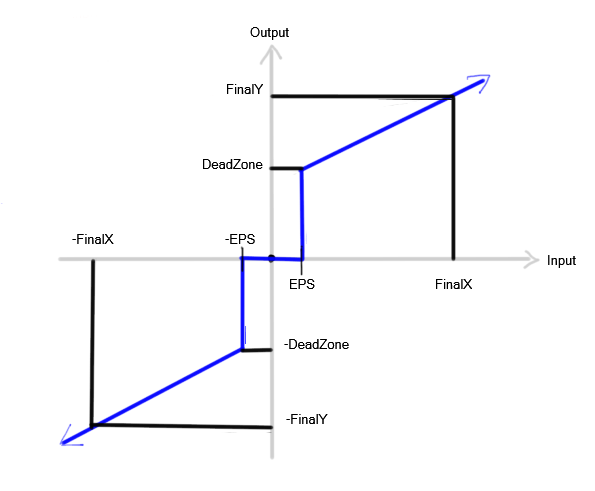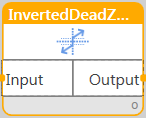Inverted Dead Zone
Full Name
Lib.Mervis.v1_0.InvertedDeadZone
Required Project References
- Lib.Mervis
Description
The block is used to eliminate the dead zone of actuators by creating its inversion.
Usage in ST
program test
var
idz: lib.mervis.v1_0.InvertedDeadZone;
end_var
idz();
end_program
Inputs
| Name | Data Type | Retain | Mandatory Connection | Meaning |
| Input | real | No | Yes | Input value |
| Eps | real | No | No | Zero band width |
| DeadZone | real | No | No | Dead zone width |
| FinalX | real | No | No | X-coordinate of the output line |
| FinalY | real | No | No | Y-coordinate of the output line |
Outputs
| Name | Data Type | Meaning |
| Output | real | Output value |
Detailed Function Description
The block is used to eliminate the dead zone of actuators in response to a change in value. The size of the dead zone is determined by the DeadZone parameter. The transfer characteristic of the block is described by the following diagram

- In the input value range
< -Eps, Eps >, the output of the block is zero - In the range
(-infinity, -Eps), the output is defined by a line with points[-Eps, -DeadZone] → [-FinalX, -FinalY] - In the range
(Eps, infinity), the output is defined by a line with points[Eps, DeadZone] → [FinalX, FinalY]
For eliminating common dead zones, the following settings are recommended:
- Eps should be chosen from the range (0, 1), depending on how wide you need the zero output band to be
- DeadZone should be chosen based on the actuator's dead zone, for example, for a 2-10 V output, select a value corresponding to 2 V
